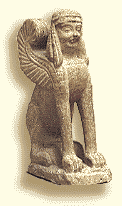  |
| ||
Etruscan Grammar: Summary1. The Inflexion of Nouns and Adjectives Etruscan is an inflecting language; which means that there can be more than one marker (= ending) to design a case, and that the same marker can occur for more than one case. There are four cases in Etruscan, answering the questions who? (a), whom? (b), whose? (c), where? (d) (= nominative, accusative, genitive, locative); with nouns, however, only three are differently expressed. The accusative occurs with own ending in pronominal forms and their compounds. That there is a difference made between pronominal and nominal inflections (the nouns and adjectives, which will be treated here), is a further typical feature of inflecting languages: the nominative and accusative forms of the Etruscan words "mother" and "father" are ati and apa, whereas "I" is called mi and "me" mini. The genitive markers are atial "mother's" and apas "father's" (c). These genitive forms are also used Etruscan is an inflecting language; which means that there can be more than one marker (= ending) to design a case, and that the same marker can occur for more than one case. There are four cases in Etruscan, answering the questions who? (a), whom? (b), whose? (c), where? (d) (= nominative, accusative, genitive, locative); with nouns, however, only three are differently expressed. The accusative occurs with own ending in pronominal forms and their compounds. That there is a difference made between pronominal and nominal inflections (the nouns and adjectives, which will be treated here), is a further typical feature of inflecting languages: the nominative and accusative forms of the Etruscan words "mother" and "father" are ati and apa, whereas "I" is called mi and "me" mini. The genitive markers are atial "mother's" and apas "father's" (c). These genitive forms are also usedThe Etruscan language doesn't possess an article (a-b) Nominative / Accusativeca shuthi "this grave" is opposite to cn shuthi cerichunce "(he) built this grave"; if the verb is in the passive voice, the noun, in Etruscan, too, will of course be a nominative: ich ca cecha zichuche "(this is) why this treaty was written". These examples show, moreover, that adjective pronouns will precede the noun and open sentences (ca cecha "this treaty"), mini muluvanice laris lethaies "me gave/offered/dedicated Laris Lethaies".(c) GenitiveThis case expresses possession, affiliation and interest. mi suntheruza spurias mlakas "I (am the) casket of (the) beautiful Spuria/for (the) beautiful Sp.". The attributive adjective (mlakas "beautiful, good") follows the noun.Sometimes groups of nouns are split up by another part of the sentence (= 'distraction', 'Hyperbaton'). mi spurias thina mlach mlakas "I (am the) beautiful Spurias's beautiful ewer (thina mlach)", mi velelias thina mlach mlakas "... (the) beautiful Velelia's (= Velelias ... mlakas)". itun turuce venel atelinas tin(i)as cliniaras "this (itun accusative) gave/donated Venel Atelinas to Tinia's (= Zeus/Juppiter) sons". This sentence includes three genitive endings with a different function for each of them. In the South of Etruria the family names of men (Lethai There also exists a genitive marker -l (which had been deleted in old Etruscan after -a): in recent Etruscan the genitive "(the) mother's" is called atial. Distribution of the endings -l and -s follows the claims of the respective words. As can be inferred from the cited examples, these different markers do not distinguish masculine from feminine gender: laives sukisnas "Laive Sukisnas'" : thanakvilus sucisnaia "Thanakvil Sucisnai's". (d) LocativeIsolated or followed by a postposition, the lovative expresses someone's or something's situation and/or proximity in space or time. Its ending -i is occasionally hard to discern.Aritimi means "in Aritim (= Arretium, Arezzo)", thii "at, near, in (the) water", tinsi tiuri=m "on (the) day and in (the) month (= tiur)", shuthithi "in (the) grave", clth shuthith "in this g." (e.g. shuthi + -i + thi), capue "in, near Capua", pershie "in, near Perusia (Perugia)" (-a merges with -i into an -e!). With the exception of tinsi all cited examples constitute so called 'simple/primary' locatives ending on -i; there exists, however, also the 'extended/secondary' locative ending on -le (for words with a genitive ending on -l) or -si (where the genitive marker is -s). The meaning can be the same, as, for instance, in the case of tinsi "on (the) day"; but more often Aranth, Laris, genitive Aranthia, Larisa (in recent Etruscan Arnth(i)al, Larisal) are first names of men, whereas Prasanaia is the genitive form of a woman's gentile (= family name); all are inflected alike, without consideration of gender differences. 2. Verb In inscriptions, mainly forms of the 3rd person are found (cesu "(is/are) interred"). Other materials are questionable (turis mi une ame "I shall (serve) Turi for pouring out (une locative)" (NHE, 306, note 2).
The constructions of verbs (transitive/intransitive; active/passive) may be disclosed, as has been demonstrated above, by analysing the case forms of the accompanying nouns. The texts show predominantly forms of the past tense. Intransitive forms of the past tense (lupu "(has) died") and forms in the passive voice (mulu "presented/present") are actually verbal nouns and will occasionally appear treated like nouns:
mi mulu lari(sa)le zili mlach (NHE, 227, D27) "I (am the) beautiful present (mulu...mlach) of/from zil- (adjective) Laris" In inscriptions, mainly forms of the 3rd person are found (cesu "(is/are) interred"). Other materials are questionable (turis mi une ame "I shall (serve) Turi for pouring out (une locative)" (NHE, 306, note 2).
The constructions of verbs (transitive/intransitive; active/passive) may be disclosed, as has been demonstrated above, by analysing the case forms of the accompanying nouns. The texts show predominantly forms of the past tense. Intransitive forms of the past tense (lupu "(has) died") and forms in the passive voice (mulu "presented/present") are actually verbal nouns and will occasionally appear treated like nouns:
mi mulu lari(sa)le zili mlach (NHE, 227, D27) "I (am the) beautiful present (mulu...mlach) of/from zil- (adjective) Laris"This, however, is no sufficient reason to classify Etruscan as an ergative language. | ||
| [Origins] | [Vocabulary] | [Place Names] |
|